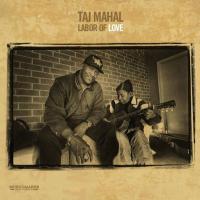Taj Mahal's "Labor of Love" Is A Field Recording Your Ears Will Like and Your Heart Will Love
Duffy's then newly created Music Maker Relief Foundation had released in the mid-nineties A Living Past, a book and CD set containing Duffy produced recordings featuring traditional blues artists that strongly resonated with blues veteran Taj Mahal.
Taj liked what Duffy was doing and how he was doing it: preserving the music and also trying to better the lives of these elderly, financially struggling artists.
The two hit it off and soon thereafter Duffy was in L.A. with Taj meeting B.B. King, The Rolling Stones and Eric Clapton, but more to the point, later visiting Duffy's rural Pinnacle, North Carolina home, where Taj became acquainted with some of the Music Maker artists and their music-making.
Using Taj's name as leverage, Taj and Duffy obtained sponsors and organized a forty two city tour featuring Music Maker Foundation artists with Taj headlining to draw the crowds. As a result, artists who'd spent a lifetime playing juke joints and bars were performing before big, appreciate audiences in major venues.
The tour was magic for all involved including Taj Mahal who, according to the liner notes of this two LP set, felt like he was getting "closer to the source". Duffy had been setting up the aforementioned recording gear in hotel rooms, hoping, without much success, to capture Taj "lightening" to tape.
In a Houston hotel room one evening Taj encountered the daughter of the Katie Mae Lightnin' Hopkins sang about in his song of the same name and soon thereafter he picked up his guitar and began playing the classics he'd learned as a youngster: "Stagger Lee", "Fishin' Blues" and Walkin' Blues" all of which are included in this set.
Back in Pinnacle, and later Music Maker's Hillsborough headquarters Taj became part of the "full-on living room scene" that produced the rest of these remarkable tracks performed by Neal Pattmann, John Dee Holeman, Cool John Ferguson, Cootie Stark, Etta Baker and Algia Mae Hinton, none of whom you are likely to have heard of until just now. Taj kicked in piano, bass, harp, banjo and mandolin but only on an "as-needed" basis.
For reasons explained in the liner notes, the music was never released—until now. In 2015 the Foundation turned twenty one and Taj was in the middle of his eighth decade. Both determined that these tracks deserved to be heard and Taj wanted it to be a vinyl-only release.
Of course this music and this project is at the core of what Analogue Productions' Chad Kassem has been about since he began producing vinyl reissues so it was only natural and fitting that these two LPs have been released on the Analogue Productions label, lacquers cut by Kevin Gray, pressed at QRP and housed in gatefold "Tip-on" Stoughton Press jackets festooned with evocative black and white session photos.
Even if you know these chestnuts like "Creole Bell", "John Henry" and "Hambone" by heart, you'll experience them here with fresh life breathed into their musical arteries. I couldn't help but notice the striking similarities, coincidental or otherwise, between "Hambone" and Paul Simon's "Wristband".
Among my favorites is Taj's instrumental "Zanzibar", but really, every track is a treasure. At the recent Consumer Electronics Show it was appreciated and noted wherever I played it, both for the music and sound.
When I first played this record at home I had no idea how it was recorded. The recording quality was obviously high and transparency great, but I felt the last bit of spatial "magic" was missing. I later found out it was recorded at 16 bit/44.1K resolution, which was probably the limit "in the old days".
Labor of Love will not be released digitally so this is it. Don't be a fool and let the resolution stop you. These are probably the best sounding damn "field recordings" you're likely ever to hear and the stripped-down music is transportive and magical.


